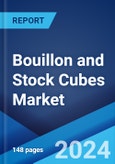The global bouillon and stock cubes market size reached USD 10.0 Billion in 2024. Looking forward, the publisher expects the market to reach USD 14.7 Billion by 2033, exhibiting a growth rate (CAGR) of 4.4% during 2025-2033. The heightened need for convenient food products to simplify cooking process, increasing demand for food products devoid of preservatives, genetically modified organisms (GMOs) and other additives, and rising focus on health and wellness among the masses are facilitating the market growth.
Bouillon and stock cubes refer to concentrated forms of stock or broth, providing a convenient and efficient way to add depth and richness to culinary preparations. They are essentially dehydrated and compressed ingredients that are composed of a combination of salt, seasonings, and flavorings, along with other ingredients that contribute to the desired taste profile. Additionally, they are widely used as flavoring agents in cooking, particularly in soups, stews, sauces, and various dishes. Stock cubes are produced by simmering meat, poultry, fish, or vegetables in water for an extended period. This slow-cooking process extracts the flavors, nutrients, and gelatin from the ingredients, resulting in a flavorful liquid known as stock. On the other hand, bouillon cubes are similar to stock cubes but may contain additional ingredients, including herbs, spices, and seasonings, to enhance the overall flavor. These cubes are manufactured by combining concentrated stock with various aromatic components. Moreover, they serve as a convenient substitute for homemade stock or broth, especially when fresh ingredients are limited. They offer a concentrated flavor base that can be quickly dissolved in hot water, creating an instant broth or stock-like liquid.
What are the drivers, restraints, and opportunities in the global bouillon and stock cubes market?
What is the impact of each driver, restraint, and opportunity on the global bouillon and stock cubes market?
What are the key regional markets?
Which countries represent the most attractive bouillon and stock cubes market?
What is the breakup of the market based on the product type?
Which is the most attractive product type in the bouillon and stock cubes market?
What is the breakup of the market based on the form?
Which is the most attractive form in the bouillon and stock cubes market?
What is the breakup of the market based on the distribution channel?
Which is the most attractive distribution channel in the bouillon and stock cubes market?
What is the competitive structure of the market?
Who are the key players/companies in the global bouillon and stock cubes market?
Bouillon and stock cubes refer to concentrated forms of stock or broth, providing a convenient and efficient way to add depth and richness to culinary preparations. They are essentially dehydrated and compressed ingredients that are composed of a combination of salt, seasonings, and flavorings, along with other ingredients that contribute to the desired taste profile. Additionally, they are widely used as flavoring agents in cooking, particularly in soups, stews, sauces, and various dishes. Stock cubes are produced by simmering meat, poultry, fish, or vegetables in water for an extended period. This slow-cooking process extracts the flavors, nutrients, and gelatin from the ingredients, resulting in a flavorful liquid known as stock. On the other hand, bouillon cubes are similar to stock cubes but may contain additional ingredients, including herbs, spices, and seasonings, to enhance the overall flavor. These cubes are manufactured by combining concentrated stock with various aromatic components. Moreover, they serve as a convenient substitute for homemade stock or broth, especially when fresh ingredients are limited. They offer a concentrated flavor base that can be quickly dissolved in hot water, creating an instant broth or stock-like liquid.
Bouillon and Stock Cubes Market Trends:
The changing consumer preference majorly drives the global market. This can be supported by modern lifestyles and hectic schedules, and time constraints leading to a rise in the demand for convenient food options. Coupled with the escalating demand for ready-to-cook and processed food products due to urbanization, dual-income households, and the need for quick meal solutions is positively influencing the market. Along with this, the rising consumer awareness about the importance of flavorful and convenient cooking solutions is driving the demand for bouillon and stock cubes. Additionally, the widespread adoption of easy-to-use products that enhance the taste of meals while saving time and effort in the kitchen is significantly supporting the market. Apart from this, manufacturers are introducing bouillon and stock cubes with reduced sodium, organic ingredients, and no artificial additives. As a result, the availability of healthier options to add flavor to meals while maintaining a balanced diet is contributing to the market. Furthermore, the introduction of innovative flavors, packaging formats, and product variations to cater to evolving consumer preferences is creating a positive market outlook. Some of the other factors driving the market include the growing interest in culinary experiments and significant growth in the food service industry.Bouillon and Stock Cubes Market Segmentation:
The publisher provides an analysis of the key trends in each segment of the market, along with forecasts at the global, regional, and country levels for 2025-2033. Our bouillon and stock cubes market report has categorized the market based on product type, form, and distribution channel.Product Type Insights:
- Vegetable
- Fish
- Meat
- Poultry
- Beef
- Others
Form Insights:
- Cubes
- Liquid
- Powder
- Granules
- Others
Distribution Channel Insights:
- Supermarket and Hypermarket
- Independent Grocery Stores
- Online Retail
- Others
Regional Insights:
- North America
- United States
- Canada
- Asia Pacific
- China
- Japan
- India
- South Korea
- Australia
- Indonesia
- Others
- Europe
- Germany
- France
- United Kingdom
- Italy
- Spain
- Russia
- Others
- Latin America
- Brazil
- Mexico
- Others
- Middle East and Africa
Competitive Landscape:
The report has also provided a comprehensive analysis of the competitive landscape in the global bouillon and stock cubes market. Detailed profiles of all major companies have been provided. Some of the companies covered include Anhui Qiangwang Flavouring Food Co. Ltd., Edwards & Sons Trading Company Inc., Golden Bird Food Industries, Goya Foods Inc., Hormel Foods Corporation, Hügli Holding AG (Bell Food Group AG), Imana Foods (Pty) Ltd., Massel Australia Pty. Ltd., Morga AG, Proliver, Rapunzel Naturkost GmbH, The Kroger Co., Unilever plc, etc. Kindly note that this only represents a partial list of companies, and the complete list has been provided in the report.Key Questions Answered in This Report:
How has the global bouillon and stock cubes market performed so far, and how will it perform in the coming years?What are the drivers, restraints, and opportunities in the global bouillon and stock cubes market?
What is the impact of each driver, restraint, and opportunity on the global bouillon and stock cubes market?
What are the key regional markets?
Which countries represent the most attractive bouillon and stock cubes market?
What is the breakup of the market based on the product type?
Which is the most attractive product type in the bouillon and stock cubes market?
What is the breakup of the market based on the form?
Which is the most attractive form in the bouillon and stock cubes market?
What is the breakup of the market based on the distribution channel?
Which is the most attractive distribution channel in the bouillon and stock cubes market?
What is the competitive structure of the market?
Who are the key players/companies in the global bouillon and stock cubes market?
Table of Contents
1 Preface3 Executive Summary11 Value Chain Analysis13 Price Analysis
2 Scope and Methodology
4 Introduction
5 Global Bouillon and Stock Cubes Market
6 Market Breakup by Product Type
7 Market Breakup by Form
8 Market Breakup by Distribution Channel
9 Market Breakup by Region
10 Drivers, Restraints, and Opportunities
12 Porters Five Forces Analysis
14 Competitive Landscape
List of Tables
Companies Mentioned
- Anhui Qiangwang Flavouring Food Co. Ltd.
- Edwards & Sons Trading Company Inc.
- Golden Bird Food Industries
- Goya Foods Inc.
- Hormel Foods Corporation
- Hügli Holding AG (Bell Food Group AG)
- Imana Foods (Pty) Ltd.
- Massel Australia Pty. Ltd.
- Morga AG
- Proliver
- Rapunzel Naturkost GmbH
- The Kroger Co.
- Unilever plc
Table Information
| Report Attribute | Details |
|---|---|
| No. of Pages | 133 |
| Published | January 2025 |
| Forecast Period | 2024 - 2033 |
| Estimated Market Value ( USD | $ 10 Billion |
| Forecasted Market Value ( USD | $ 14.7 Billion |
| Compound Annual Growth Rate | 4.4% |
| Regions Covered | Global |
| No. of Companies Mentioned | 13 |









